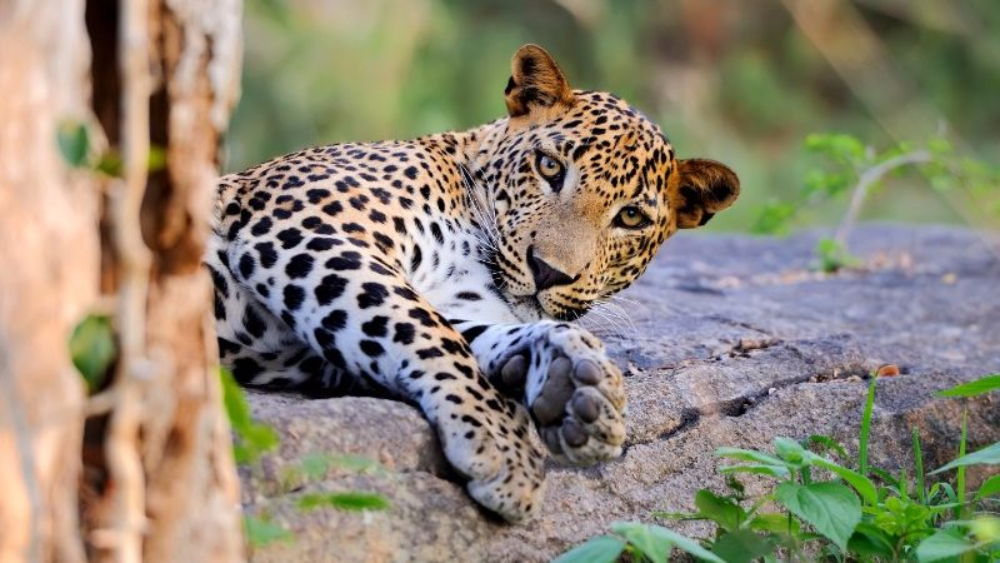The Sri Lankan leopard (*Panthera pardus kotiya*), a majestic and elusive big cat, is one of the most iconic and endangered wildlife species in Sri Lanka. This leopard subspecies is endemic to the island, making it a crucial part of Sri Lanka’s natural heritage. Despite its cultural and ecological significance, the Sri Lankan leopard faces numerous threats that endanger its survival. This article delves into the biology, habitat, behavior, conservation status, and efforts to protect this magnificent creature.
Physical Appearance of the Sri Lankan Leopard
The Sri Lankan leopard is a medium-sized leopard subspecies, with males typically larger than females. Males can weigh between 56-77 kg (123-170 lbs) and measure about 142-170 cm (56-67 inches) in body length, while females are slightly smaller, weighing 29-34 kg (64-75 lbs) and measuring 114-140 cm (45-55 inches). Their coat is a beautiful golden-yellow with distinctive black rosettes, which provide excellent camouflage in their forest habitats.
Genetic Uniqueness
Genetically, the Sri Lankan leopard is distinct from other leopard subspecies. Studies show that it has been isolated from other leopard populations for around 500,000 years, contributing to its unique genetic makeup. This long period of isolation has allowed it to adapt specifically to the environmental conditions of Sri Lanka.
Habitat and Distribution
The Sri Lankan leopard inhabits a variety of ecosystems across the island, from dense rainforests and montane forests to dry lowland forests and scrublands. However, their highest densities are found in the country’s protected areas, such as Yala National Park, Wilpattu National Park, and Horton Plains National Park.
Home Range and Territory
Leopards are solitary animals with well-defined territories. The size of their home range can vary significantly depending on habitat type and prey availability. In densely forested areas with abundant prey, a male’s territory might cover around 15-20 square kilometers, while in less fertile areas, territories can be much larger.
Diet and Hunting
The Sri Lankan leopard is an apex predator, meaning it sits at the top of the food chain with no natural predators. Its diet is highly varied, including deer, wild boar, monkeys, birds, and smaller mammals. Occasionally, they may prey on domestic livestock, which often brings them into conflict with humans. Leopards are stealthy hunters, relying on their camouflage, agility, and powerful build to ambush prey.
Reproduction and Lifespan of Sri Lankan Leopard
Leopards reach sexual maturity at around 2.5 to 3 years of age. Breeding can occur year-round, but there may be peaks in certain seasons. After a gestation period of approximately 90-105 days, females give birth to a litter of 1-3 cubs. Cubs remain with their mother for up to two years before becoming independent. In the wild, leopards can live up to 12-15 years, though this can be longer in captivity.
Behavior and Adaptations
These leopards are highly adaptable and elusive, often displaying behaviors that minimize encounters with humans. They are primarily nocturnal, which helps them avoid daytime human activity. Despite their solitary nature, they communicate through vocalizations, scent markings, and visual signals.
Threats to Survival
The Sri Lankan leopard is classified as Endangered by the International Union for Conservation of Nature (IUCN). Several factors contribute to its precarious status, including habitat loss and fragmentation, human-wildlife conflict, poaching and illegal trade, and road accidents. Deforestation for agriculture, urbanization, and infrastructure development has severely fragmented the leopard’s habitat, restricting their range and reducing prey availability. Leopards sometimes prey on livestock, leading to retaliatory killings by farmers. This conflict is exacerbated by the shrinking of natural prey populations. Leopards are also targeted for their skins, bones, and other body parts, which are highly valued in illegal wildlife trade. Increasing road networks within their habitats have led to a rise in leopard fatalities due to vehicle collisions.

Conservation Efforts for Sri Lankan Leopard
Several conservation initiatives are underway to protect the Sri Lankan leopard. Establishing and maintaining protected areas such as Yala and Wilpattu National Parks are crucial for providing safe havens for leopards. These parks also promote eco-tourism, raising awareness and funds for conservation. Conservation organizations work with local communities to reduce human-leopard conflicts. This includes providing compensation for livestock losses and promoting livestock management practices that minimize leopard attacks. Scientific research on leopard behavior, genetics, and ecology helps in understanding their needs and threats. Monitoring populations using camera traps and tracking technologies is vital for effective conservation planning. Strengthening law enforcement to combat poaching and illegal trade is essential. This includes increasing patrols, improving legal frameworks, and enhancing penalties for wildlife crimes. Efforts to restore degraded habitats and create wildlife corridors can help in maintaining genetic diversity and connecting isolated leopard populations.
The Role of the Public
Public involvement is crucial for the conservation of the Sri Lankan leopard. Awareness campaigns, eco-tourism, and community-based conservation projects can significantly contribute to protecting these magnificent cats. By understanding the importance of biodiversity and the role of apex predators, people can become advocates for conservation.
Conclusion
The Sri Lankan leopard is a symbol of the island’s rich biodiversity and cultural heritage. Protecting this endangered subspecies requires concerted efforts from government agencies, conservation organizations, local communities, and the global community. Through habitat conservation, anti-poaching measures, community engagement, and scientific research, it is possible to secure a future for the Sri Lankan leopard and ensure that it continues to roam the forests of Sri Lanka for generations to come.









